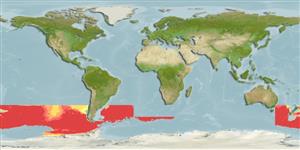>
Lophiiformes (Anglerfishes) >
Oneirodidae (Dreamers)
Etymology: Oneirodes: Greek, 'oneiros' = a dream or dreamlike or out of a dream (suggesting this fish is so strange and marvelous that can exist only in dreams) (Ref. 86949).
Environment: milieu / climate zone / depth range / distribution range
Ökologie
seewasser bathypelagisch; tiefenbereich 700 - 2000 m (Ref. 86949), usually 800 - 1100 m (Ref. 86949). Deep-water; 36°S - 77°S
Southern Ocean: sub-Antarctic and Antarctic waters.
Size / Gewicht / Alter
Maturity: Lm ? range ? - ? cm
Max length : 15.0 cm SL (female)
Kurzbeschreibung
Morphologie | Morphometrie
Rückenflossenweichstrahlen (insgesamt): 5-7; Afterflossenweichstrahlen: 4. Characterized by having escal morphology: esca with a stout, internally pigmented appendage, usually bearing a compressed papilla and 2 tapering filaments on distal tip; several small tapering filaments along posterior margin of anterior escal appendage; papilla and filaments of anterior escal appendage unpigmented; rounded or truncated terminal escal papilla with a distal streak of pigment; unpigmented, unbranched tapering posterior escal appendage as long as or shorter than escal bulb; absence of lateral and anterolateral appendages; relatively short and broad subopercle, without indentation on posterodorsal margin; length of ventral fork of opercle 25.2-32.2% SL; ratio of lengths of the dorsal and ventral forks of opercle 0.52-0.59; absence of epibranchial teeth; presence of teeth on pharyngobranchial II; upper jaw teeth 20-37, lower jaw teeth 22-48; teeth on vomer 4-7; dorsal fin rays 5-7; anal fin rays 4; pectoral fin rays 17-19; head length 35.0-46.2% SL; head depth 36.3-48.8% SL; premaxilla length 25.0-35.0% SL; length of lower jaw 38.3-50.0% SL; length of illicium 19.1-28.3% SL (Ref. 86949).
Larvae are epipelagic, young and adults are mesopelagic or bathypelagic (Ref. 47377). Minimum depth from Ref. 58018.
Life cycle and mating behavior
Geschlechtsreife | Fortpflanzung | Ablaichen | Eier | Fecundity | Larven
Pietsch, T.W., 1990. Oneirodidae. p. 212-213. In O. Gon and P.C. Heemstra (eds.) Fishes of the Southern Ocean. J.L.B. Smith Institute of Ichthyology, Grahamstown, South Africa. (Ref. 5186)
IUCN Rote Liste Status (Ref. 130435)
Bedrohung für Menschen
Harmless
Nutzung durch Menschen
Fischereien: nicht kommerziell
Mehr Information
NamenSynonymeMetabolismusRäuberÖkotoxikologieFortpflanzungGeschlechtsreifeAblaichenSpawning aggregationFecundityEierEientwicklung
Alter/GrößeWachstumLänge-GewichtLänge-LängeLängenhäufigkeitenMorphometrieMorphologieLarvenLarven Pop.Dyn.RekrutierungDichteBRUVS
ReferenzenAquakulturAquakultur ProfilZuchtlinienGenetikElectrophoresesVererbbarkeitKrankheitenVerarbeitungNutrientsMass conversion
PartnerBilderStamps, Coins Misc.LauteCiguateraGeschwindigkeitSchwimmstilKiemenoberflächeOtolithsGehirngrößeSehfähigkeit
Tools
Zusatzinformationen
Download XML
Internet Quellen
Estimates based on models
Preferred temperature (Ref.
123201): 0.2 - 1.9, mean 1.3 °C (based on 19 cells).
Phylogenetic diversity index (Ref.
82804): PD
50 = 0.5000 [Uniqueness, from 0.5 = low to 2.0 = high].
Bayesian length-weight: a=0.01995 (0.00906 - 0.04395), b=3.01 (2.83 - 3.19), in cm total length, based on all LWR estimates for this body shape (Ref.
93245).
Trophic level (Ref.
69278): 4.1 ±0.7 se; based on size and trophs of closest relatives
Widerstandsfähigkeit (Ref.
120179): mittel, Verdopplung der Population dauert 1,4 - 4,4 Jahre. (Preliminary K or Fecundity.).
Fishing Vulnerability (Ref.
59153): Low vulnerability (10 of 100).
